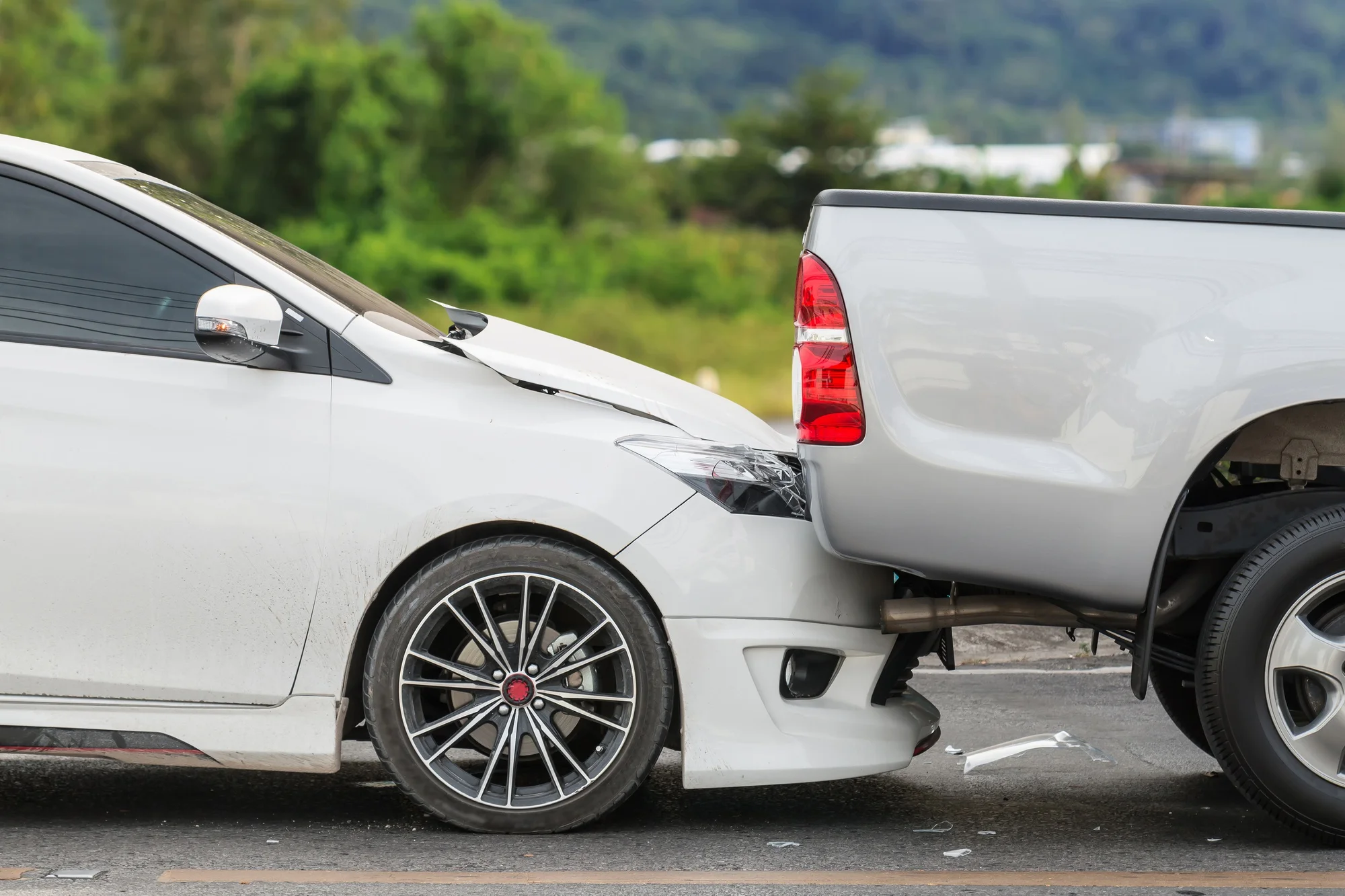Everyone knows that car accidents can be devastating. Injuries resulting from car crashes can range from minor to severe to fatal. A study from the National Highway Traffic Safety Administration showed approximately 2.74 million people injured in traffic accidents in 2019. Every year, Americans spend 1 million days in the hospital due to injuries resulting from traffic accidents, costing $18 billion in medical bills and $33 billion in lost wages. Below are just some of the common car accident injuries that may occur.
Common Physical Injuries
Car accidents can have devastating and long-lasting impacts on the human body. There are several types of injuries that can be sustained which can be moderate and superficial to permanent and debilitating.
Head & Traumatic Brain Injuries
Traumatic brain injuries, or TBI, are often caused by motor vehicle accidents. Every year an estimated 50 thousand TBI result in fatalities and another 80 to 90 thousand result in permanent disability. In children, TBI can result in developmental delays.
One of the most well-known brain injuries is the concussion. There may be external injuries such as cuts and bruising caused by impact against a window or steering wheel, but the internal injuries may be much worse. Blunt force trauma to the head can cause the brain to move and collide with the inside of the skull. Even minor head injuries can cause serious damage. If the damage is inside of the head, it can be difficult to assess how serious the injury is without further inspection and analysis. TBIs are also slow to appear and can worsen over time. This is why all head injuries are carefully monitored and handled as serious. Diagnosis may be difficult, but it is important for individuals to be aware of any cognitive changes in concentration, problem solving, retaining information, and information recall.
Serious TBIs can lead to issues with memory, cognitive function, balance, sensory input, and even moods and personality. Head injuries can also cause chemical changes in the brain which can lead to mental health issues. If someone suffers multiple concussions, this can cause ongoing brain damage.
Spinal Cord Injuries & Paralysis
The impact and jarring movements of a car crash can result in spinal cord injuries. Damage to the vertebrae or spinal cord can then result in paralysis below the point of injury. There are various results of a spinal injury:
- Chronic pain
- Infertility
- Mobility loss
- Respiratory issues
- Sensory loss below point of injury
- Inability to register pain or temperature
- Spasms and reflexive issues
There is currently no treatment or cure available for severe spinal cord injuries that result in partial or complete paralysis. Even with extensive surgeries and physical therapy, long lasting impacts of a spinal cord injury can include the use of a wheelchair or other mobility assistance equipment for the rest of an injured party’s life.
Back Injuries
There are many ways someone can injure their back in a car accident. Back pain can be debilitating, and some injuries may not be evident immediately after the accident or worsen over time. Some back injuries are so severe they can cause permanent disability and prevent people from working or living their lives as they did before. There are many types of back injuries that can cause extreme pain and mobility issues:
- Damaged nerves caused by injury to the nerves themselves
- Pinched nerves caused by compressing pressure
- Ruptured disc caused by damaged vertebrae
- Slipped disc or hernia caused by vertebrae slipping out of place
- Sprain caused by torn or stretched ligaments
- Strain caused by pulled muscles and tendons
Neck Injuries & Whiplash
The most common car accident injury is whiplash, with approximately 120,000 cases each year. Whiplash is caused by rapid back and forth movement of the head. The weight of the head can put strain on the neck, causing serious damage to the soft tissues in the neck. This is an injury most commonly seen in rear-end collisions. Cars going as slowly as 15 mph can cause whiplash, regardless of whether the person is wearing a seatbelt.
Car accidents may also lead to damage and dislocation of the cervical spine. Trauma to the neck can be caused by impact with steering wheels or airbags as well. While these types of injuries generally heal within a few weeks to a few months, they can sometimes result in lifelong pain.
Common symptoms include:
- Stiff neck with pain that intensifies with movement
- Reduced range of motion in neck and shoulders
- Dizziness
- Fatigue
- Headaches
- Loss of mobility in the neck
- Numbness or tingling in the neck
- Pain in upper back, shoulders, and arms
Less obvious symptoms include:
- Blurred vision
- Concentration issues
- Depression
- Change in personality or behavior
- Irritability
- Emotional issues
- Insomnia
- Memory issues
- Ringing in ears
Burns
When a person is in a car accident, they can be exposed to burning metal, hot liquids, and even open flames. The more severe a burn is, the longer it takes to heal. Burns sustained in car accidents may even be severe enough to require surgery. There are four types of burns:
First degree
- Light damage to top layer of skin
- Skin is reddened but no blistering
- Heal time 1-2 weeks
Second degree
- More intense damage to top layers of skin
- Skin is blistered and swells with liquid
- Heal time 2-3 weeks
Third degree
- Damage to all layers of skin as well as nerves and lower tissue
- Skin is leathery and discolored
- Heal time several months with possible permanent loss of function
Fourth degree
- Damage down to fatty tissue, muscles, or bone
- Skin is blackened and charred
- Permanent loss of function
- May result in amputation
- Possibly fatal
Internal Injuries & Bleeding
Blunt force trauma that does not penetrate the skin can still cause internal bleeding and damage to the organs, muscle, and bones. These injuries can be severe and require immediate treatment. The nature of internal injuries means that it is impossible to see the extent of the damage without testing. It may also take time for the injured person to realize they have even been injured, which is a major reason why car accident victims are encouraged to seek medical treatment right away. Abdominal bruising can be a sign of internal bleeding or organ damage and can often be caused by incorrect use of a seatbelt.
Fractures & Broken Bones
There are over two hundred bones in the human body. Broken bones are one of the more common injuries sustained in a car accident. Even lifesaving safety features like seatbelts and air bags can cause nose and rib fractures in the course of preventing more serious injuries. Sometimes, it is not immediately obvious that a bone has been broken, which is another reason why it is so important to seek immediate medical attention after an accident. There are many different types of fractures:
- A closed fracture occurs when the bone is broken but the skin is not.
- A displaced fracture occurs when the bone is broken into separate pieces that move.
- A non-displaced fracture occurs when a broken bone stays in place.
- An open fracture, also known as a compound fracture, occurs when the bone breaks through the skin.
- A partial fracture occurs when the bone is cracked but not broken.
- A stress fracture occurs when a hairline crack in the bone appears.
These are just some of the more common general classifications of fractures. There are other types of fractures that are defined by their location, the way they move, and other qualities.
Disfigurement
Burns and lacerations can sometimes scar and leave a person disfigured. When someone experiences unwanted changes to their appearance, it can cause anxiety and depression. For some people, their physical appearance is part of their profession and any changes to that appearance can affect that person’s ability to work. While some scars can be treated and reduced with plastic surgery, many are permanent. Healing scars can also affect the surrounding skin causing pain and discomfort or even mobility issues. Wounds that scar are also at risk of infection and may cause additional health issues as they heal.
Facial Injuries
The face is home to many important and delicate structures that don’t take much to inflict damage. Four of the five senses are entirely processed through the face and head. There are many different types of facial injuries:
- Broken bones and cartilage which can be difficult to heal
- Burns which can require grafting and often lead to scars or discoloration
- Dental trauma which can result in broken or lost teeth
- Eye trauma which can lead to blindness
- Soft tissue damage which can affect mobility
- Lacerations which can result in stiches or surgery to repair
Any of these injuries can cause lifelong disfigurement and disabilities.
Limb Loss & Amputation
There are approximately 1.7 million people in the country today living with a lost limb. Extremities can be lost in the course of a car accident or be injured to the point that they need to be surgically removed. These injuries can severely impact a person’s life and end up causing permanent disability. Recovery from these types of injuries can be difficult and extensive, involving specialists, physical rehabilitation, pain management, and expensive medical equipment such as prostheses and mobility aids.
Knee Injuries
The knees are in a vulnerable position during a car accident. The knees can be severely damaged in rear end accidents or multiple care pileups that result in crushing injuries caused by the engine compartment being pushed into the legs of a driver or passenger. This can also be the result of a rear impact that throws a front seat passenger into the dashboard. These impacts can cause bruising, fracture, or crush the kneecaps. Movements like improper twists or bends can also tear the cartilage and tendons in the knees.
Leg & Foot Injuries
The legs and feet are also especially vulnerable for drivers and sometimes front seat passengers due to their legs being stretched in front of them. During a head on collision, their feet and legs would take the force of the impact. The feet are comprised of numerous small delicate bones and tendons wrapped in thin skin, making them particularly susceptible to damage.
Shoulder Injuries
The most common type of shoulder injuries in a car accident are those obtained when a person tries to brace for impact. In preparation for impact, a passenger or driver will stiffen the joints in the shoulders lock which absorb the force of the crash. This is particularly dangerous for drivers who brace against a steering wheel which can result in serious damage caused by the steering column or the airbag when it deploys. These types of injuries can also have painful impacts on the soft connecting tissues that surround the back and neck.
Wrist, Hand, & Arm Injuries
Like the shoulders, the rest of the arms and hands can be injured when used to brace for impact. A broken wrist, also known as a distal radius fracture, is a common injury during car accidents and may even need surgical repair. The hands, like the feet, are vulnerable to damage including loss of motor function and even digit amputation.
Cuts & Scrapes
Broken glass from flying debris in the car and broken windows are common elements of a car accident and often result in cuts and scrapes. These injuries are usually minor and only need to be cleaned and bandaged. However, some can be more severe and need stitches as well. The most severe cases of cuts and lacerations are when they damage tissues in vital organs like the eyes, abdomen, or near critical arteries.
Bruising
Generally speaking, although they can be quite painful, bruises are often only minor injuries. They are common in seatbelt injuries which apply significant pressure to the body on impact. However, after a car accident, it is better to be on the safe side and keep an eye on any bruising, as it may be indicative of a much more serious injury. In these situations, bruising can sometimes go deeper than the skin, into the muscle, and even down to the bone.
Bruising can also sometimes be a sign of internal bleeding. Deep bruising on the torso may be a sign of damage to the internal organs. Head bruises should always be monitored due to the risk of brain injury. There are several things to look out for when bruising may be a sign of something serious:
- Aches and pains not improving / getting worse
- Blood in urine
- Increased swelling
- Fever
- Headaches
- Injury located in the head or abdomen
- Mobility issues
- Nausea or vomiting
- Numbness or weakness
- Rapid pulse
- Vision issues
Being Crushed
Crush injuries are sustained when pressure and compression are applied to the body. This can be a common occurrence when collisions are involved, and these types of high impact car accident injuries typically happen in high-speed car accidents. The result is the car is compressed causing the trunk and engine compartments to shift into spaces where passengers are sitting. A crush injury can cause damage to all parts of the body, the severity of that damage depending on the location of the injury and the force of the pressure. Some common crush injuries include broken ribs and internal bleeding.
Soft Tissue Injuries
Soft tissue refers to the muscles, ligaments, and tendons. Things like sprains and whiplash are considered soft tissue injuries. These often occur due to the sudden jarring movements of the body during a car accident. The soft tissues may become stretched or even torn, causing a tremendous amount of pain and long-lasting damage.
Emotional Damages
While there are numerous types of physical injuries one can sustain in a car accident, there is also the risk of mental injury as well.
Post-Traumatic Stress Disorder
Post-traumatic stress disorder (or PTSD) is a common result of events like car accidents. As the name suggests, PTSD is the extreme stress and anxiety that can manifest after a traumatic experience. This may result in anxiety in the person’s daily life as well as moments of panic. When someone suffers from PTSD after a car accident, they may have difficulty being in a car again. They may experience flashbacks to the accident or experience panic attacks. Insomnia, nightmares, and other mood disorders are also common after an accident. As important as it is to seek medical attention after an accident for physical injuries, it is just as important to seek mental health treatment for emotional injuries as well.
Factors That Impact the Severity of Injury Sustained in a Car Accident
There are many variables involved in the severity of a car accident injury such as:
- Whether or not the car had airbags
- How fast the cars were going
- Where the car was hit (front, rear, or side)
- Where the person was sitting in the car
- What direction the person was facing
- Whether or not the person was wearing a seat belt
Generally speaking, the two main types of car accident injuries are impact injuries and penetrating injuries. Impact injuries refer to types of blunt force trauma such as colliding with the dashboard. Penetrating injuries refer to lacerations and other trauma that breaks the skin, often caused by things like broken glass.
What To Do If You Have Been in a Car Accident
There are several steps every accident victim should take right away.
- Seek Medical Attention Immediately – After an accident, things like shock and adrenaline may prevent a person from feeling the full extent of their injuries. Things like TBI and internal bleeding may also not be noticeable right away and worsen quickly. It is always advised to see a doctor after an accident.
- Track Expenses – There are many ways in which an accident can affect someone financially, so it is important to keep track of all financial records, bills, and expenses. These documents are valuable evidence for calculating compensation:
- Property Damage
- Medical Bills
- Funeral Costs
- Loss of Income
- Speak To an Attorney – Consulting with a car accident lawyer first can be beneficial in many ways. They can go over the case with you, answer any questions you may have, and advise you on what to do next. Personal injury claims can be complicated and stressful. An attorney can take care of a great deal:
- Filing the claim
- Investigating the facts
- Determining liability
- Calculating the value of the claim
- Organizing legal strategy
- Negotiating a settlement agreement
- Appearing in court
Contact Mesriani Law Group if You Have Been a Victim in a Car Accident
Car crashes are a harrowing experience, and the resulting injuries can impact your life in many ways. Navigating the legal system can be complicated and stressful, and the statute of limitations to file a personal injury claim is just two years. Our car accident lawyers are experienced and dedicated to helping you through this difficult time and fighting to get you the compensation you deserve. If you have been injured in a car accident, call Mesriani Law Group for a free consultation today.
Car Accident Injury FAQs
What is the most common injury from a car accident?
The most common injury sustained from car accidents is whiplash. Most often the result of rear-end collisions, whiplash is damage to the soft tissue of the neck caused by rapid back and forth movement of the head. It is a painful injury that can cause stiffness and mobility loss in the neck, but generally heals within approximately three months.
What is a serious injury in an accident?
Common serious injuries in a car accident include TBI, internal bleeding, and severe burns. TBI and internal bleeding are generally caused by blunt force trauma and may be difficult to detect at first. Severe burn injuries can sometimes lead to infections and amputations. Any injury sustained in an auto accident should be considered potentially serious and examined by a medical professional right away.
What are considered major injuries?
Injuries that can lead to long term disability, permanently reduced quality of life, or death are considered major injuries. These can include spinal damage, loss of limbs, and vital organ damage. Some major injuries may appear minor at first and worsen over time.








